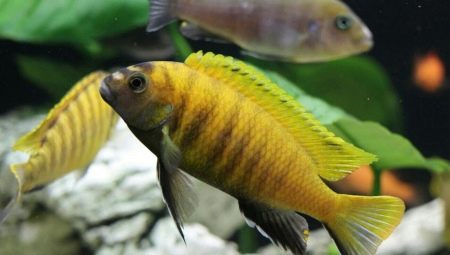Malawi cichlids are one of the most popular and common inhabitants of aquariums. They fell in love for a beautiful bright color and a peculiar manner of behavior, as well as unpretentiousness in content.
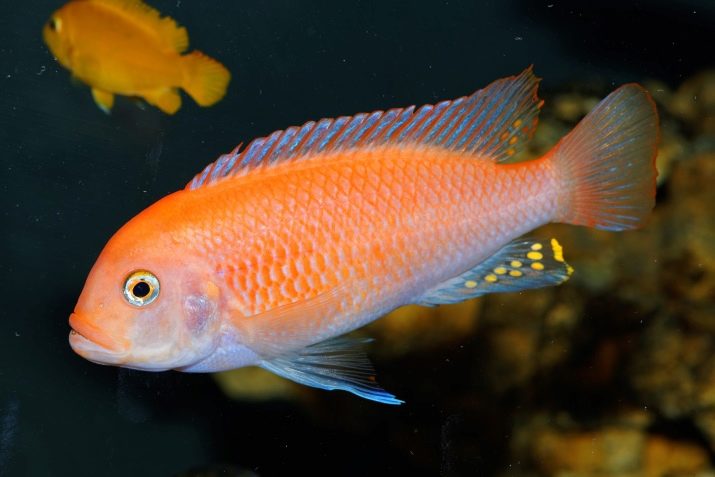
Features
Lake Malawi, The name of the fish is located in East Africa and is one of the largest on the planet. Because of its elongated size, it lies on the border of three states: Malawi, Mozambique and Tanzania. It used to be called Nyasa., although even now it is sometimes called so. A distinctive feature of this freshwater lake is that 14 rivers flow into it, and only one flows out. The water level is kept at one point due to evaporation.
For this reason, the water in the lake is quite hard and slightly salty. The bottom of the reservoir is rocky, consisting mainly of sedimentary rocks. In Malawi, a huge number of fish of different families are found, the most numerous of which are cichlids. There are about 500 species, most of which are endemic. Fishing in the lake is not prohibited; some commercial species from Malawi, for example, tilapia, are also sold in our country.
Malawi cichlids are actively sold to aquarists from different countries.
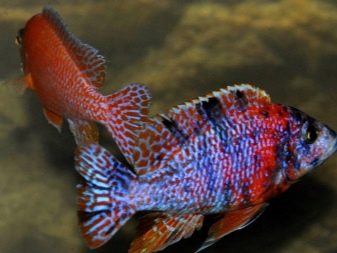
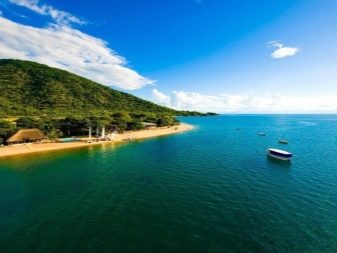
What do they look like?
African Malawi belong to the percussion order. The body of the fish is mainly elongated, and sometimes rounded, slightly flattened on the sides. The head is quite large. In males, there is often a growth on the forehead, which indicates that they have reached adulthood. Males also have bright points on the lower fin, which indicate a willingness to mate.
Males have an elongated and pointed dorsal fin, but in females it has a blunt rounded edge. The color of the fish is colorful, colorful, the size is medium, in length they can reach from 12 to 20 cm. With good care, they live in an aquarium up to 15 years. Each species has its own differences. In an excited state or during spawning, colors become brighter, more saturated, with spectacular patterns.
Malawian cichlids are highly active, they are constantly in motion. You need to give the acquired fish time to adapt.
At first, she will seek shelter and hide, but then she will get used to the owner and even begin to swim to the glass when she sees it. In relation to relatives, they stand out with a high level of aggression.
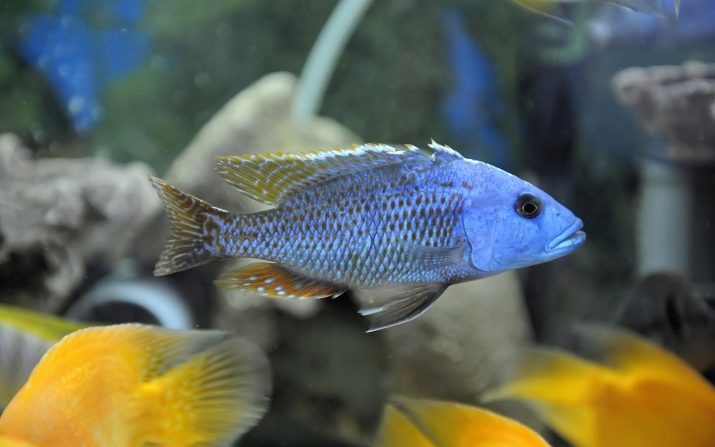
Varieties
African cichlids are divided into two main groups:
- mbuna;
- utaka.
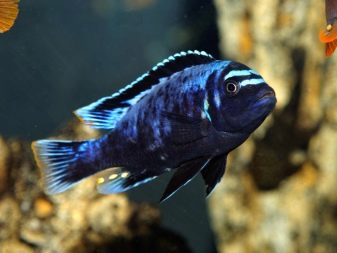
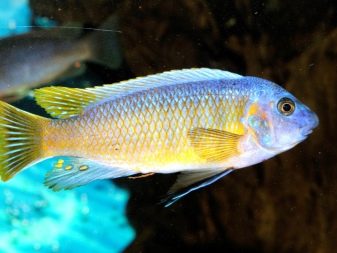
The main difference between these fish is the way they eat. The first species includes individuals that feed on plant foods. Under the natural conditions of Lake Malawi, they eat algae, which cover the rocky bottom of the reservoir. The structure of the jaws of males is similar to a grater, such teeth perfectly help to scrape vegetation from stones. Therefore, for cichlids Mbuna need to choose a spacious aquarium and provide it with a sufficient number of shelters and algae.
Plants should have strong, powerful roots, because fish love to dig up the bottom and pull out algae. Mbunas are medium in size and reach a maximum length of 12 cm.
The colors of the female and male are almost the same. This group is the largest among the inhabitants of Lake Malawi.
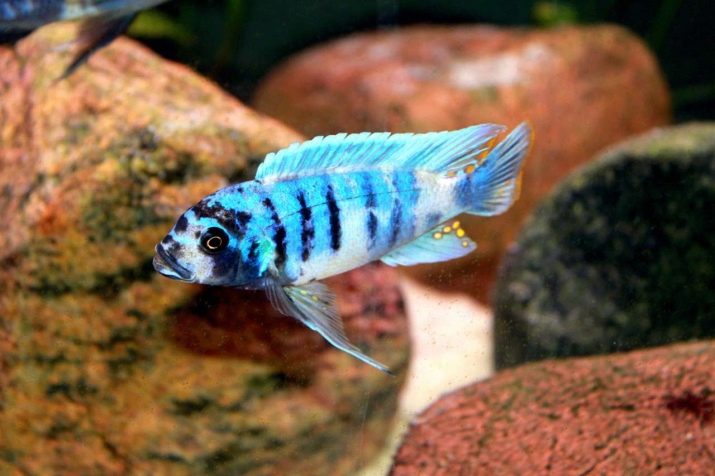
Pseudotrophies characterized by coloring with vertical stripes. Males zealously defend their territory, but young fish and females swim in flocks.
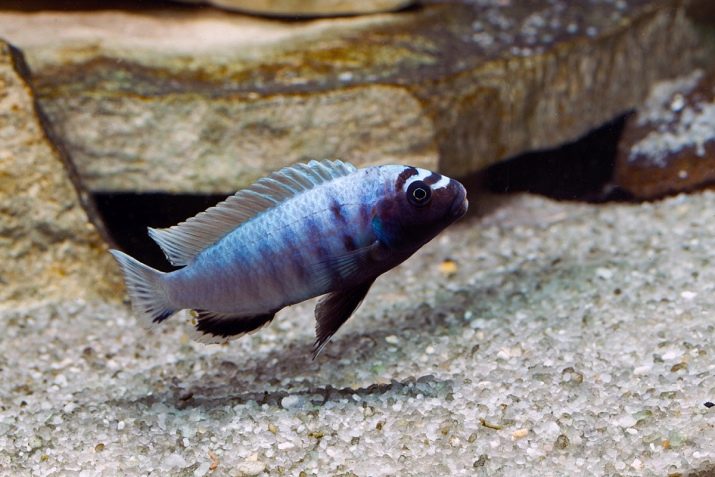
Zebra Mbuna It has an elongated physique with a slightly convex head and pointed fins. The color of the fish can be very different: orange, blue or black and white with vertical stripes of a darker tone.
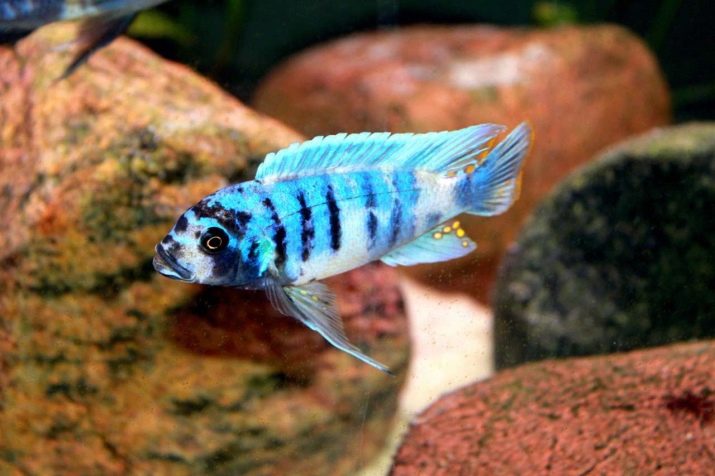
Golden cichlid It differs in a golden color with rather large dark stripes located horizontally. Refers to very aggressive representatives of mbuna.
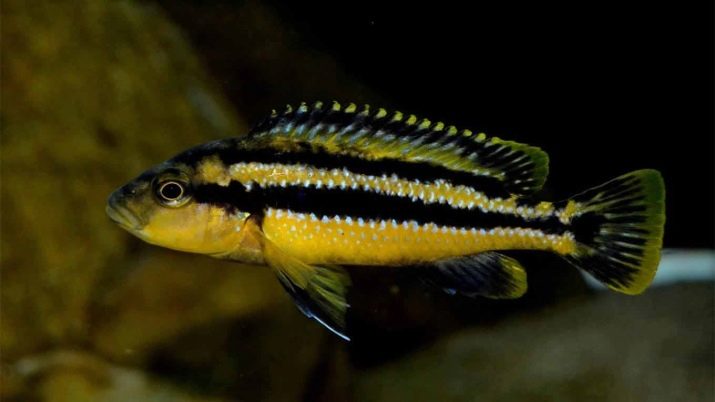
Blue dolphin It has a blue tint. A slightly elongated mouth and a hump located on the occipital part of the head give this fish a certain resemblance to a dolphin.

Labeotrophus, having a large head with a slightly elongated, hook-like mouth, may have several color options. The most common is blue or cyan with a dorsal fin of red or orange. Males on the anal fin have a pattern of several yellow dots.
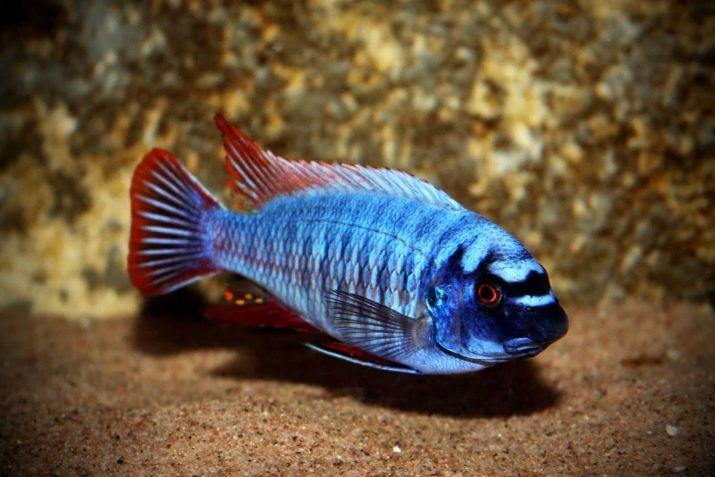
Bumblebee Cichlid It is characterized by a yellow color, the tips of the fins have a blue tint, and the body is covered with black stripes, which is why the fish got this name. Males have brighter colors than females.

In addition to these fish, the mbuna group is represented by a huge number of different individuals with no less beautiful and spectacular colors.
To the second group are the utaks, the predatory Malawian cichlids belong. In the natural environment, they live in the underwater reefs of the lake. The basis of their diet is fry of other fish and tiny crustaceans that are found in the upper layers of Malawi. Ducks differ in rather large sizes (their length is 15-20 cm) and neutral color. Males acquire a more intense color when they reach puberty, and females do not change it.
Typical representatives of the utak group are Aulonokara. They have an elongated body with a rather large head and a well-defined dorsal fin. On their head they have a characteristic depression, which is very sensitive. The color of these fish is gray with a variety of stripes and specks. Females are smaller than males.
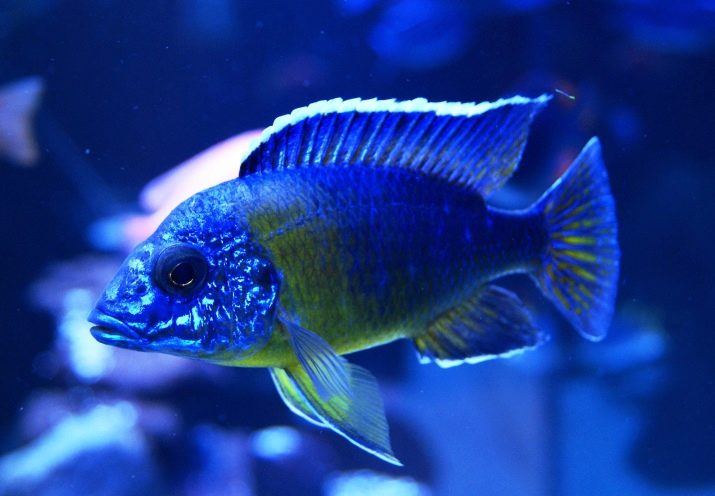
Aulonokara they have the ability to freeze in water, in nature this helps them in the hunt.After all, such a fish does not attract attention, but the recess on the head is capable of perceiving any, even the most insignificant fluctuations in water, which makes Aulonokara excellent hunters. In addition to them, other species belong to the representatives of this group, although they are not as diverse as mbuna.
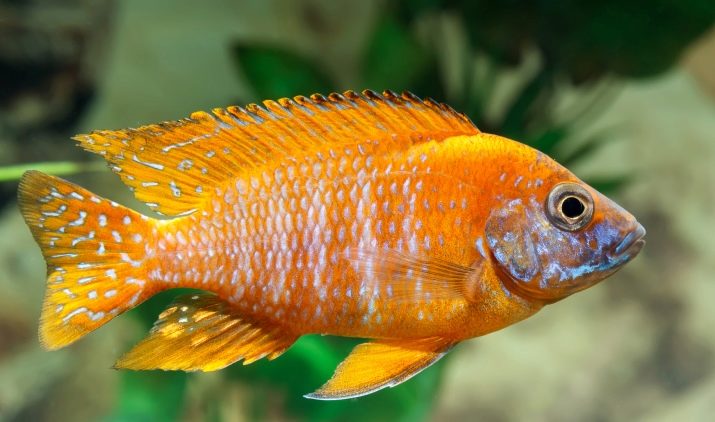
Red cadango has a large head with a rather large mouth. The body of the fish is orange or red with a blue head. The colors of the females are more modest: gray or silver.
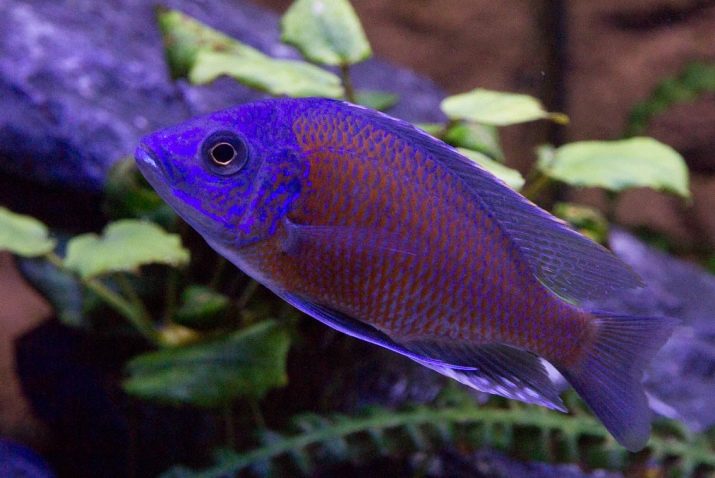
Dimidochromis has a flattened body and is considered the flattest inhabitant of Lake Malawi. Color - metallic blue with a slight green tint. Orange hues with colored dots. Females are silver.
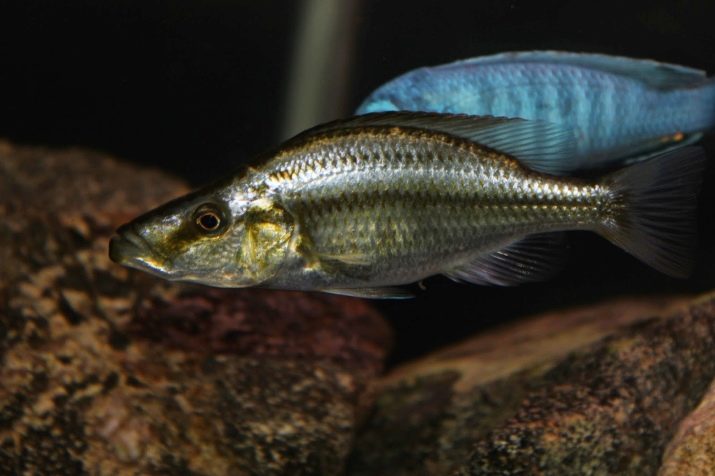
Species of fish are also found in Lake Malawi, which can be attributed to both Mbuna and Utaka. These include haplochromis consuming both plant and animal food. Cornflower haplochromis in appearance is similar to an ordinary perch. The males have a rich blue color with yellow or reddish lower hind fins, while the females have a grayish-brown color with transverse stripes throughout the body. As they grow older they also acquire a blue color, but not as bright as the males.
In an aquarium, this species of fish prefers the middle and lower layers of water. Among fish lovers, haplochromis are appreciated for their beautiful color.
Unlike cornflower blue, Livingston's haplochromis or leopard cytocar has a blue-green body with large dark spots and an extremely aggressive character.
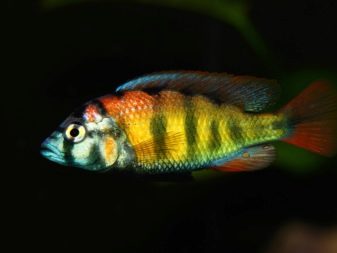
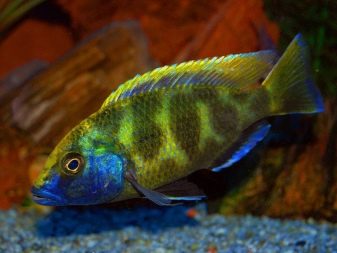
Rules for keeping and feeding
The conditions for keeping Malawi cichlids as aquarium fish directly depend on the group to which they belong. Indeed, mbuna and duck have different requirements for both the contents of the aquarium and the food. First of all, you need to know that fish need a spacious aquarium of 150 liters, although a capacity of 60 liters is quite suitable for a pair of cichlids. It is necessary to replace a third of the volume of water with clean water every week, and also use filters and compressors for air exchange and the formation of a weak current. In addition, you need to beautifully equip the aquarium with different stones and snags, which fish use as shelters.
For algae-eating mbuna, a large number of algae, both floating and those that are planted in the ground, are needed. It must be remembered that fish love to rummage in the ground, so plants should be applied with stones so that cichlids do not uproot them. For a duck, vegetation in an aquarium is undesirable, but grottoes and pebbles will do just fine. Vegetable food with a small amount of animal protein is suitable for Malawian mbuna cichlids, and they also eat cucumbers, lettuce or dandelion leaves, spinach. Utaka is fed protein foods they do not eat vegetable.
These predators like bloodworms, daphnia love, in addition, you can independently cook minced seafood and freeze it in portions. On sale there is a fairly large assortment of balanced feed for cichlids.
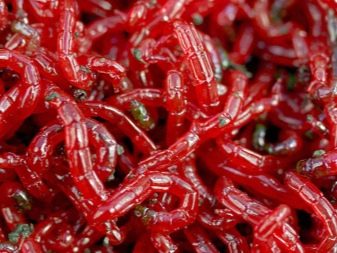
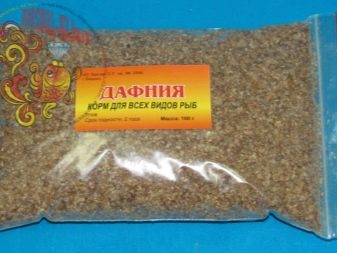
Compatibility
Malawi cichlids are quite aggressive in nature and are also used to defending their territory. It is not necessary to place fish of different sizes in one aquarium; the inhabitants of rocky areas with sandy inhabitants also get along poorly. For each species, it is better to acquire only one male in order to avoid conflicts. Some representatives of cichlids are especially aggressive even to individuals of their species, therefore they are kept behind separate glass partitions, such as Livingston's haplochromis. To avoid fights It is worth releasing cichlids into the aquarium at the same time, so there will not be a division into more developed and newcomers.
Due to aggressive behavior, fish need to equip a sufficient number of secluded places where they can wait out the danger. Of the other species, along with the African cichlids, the synodonts and some representatives of the iris species get along quite well.Content with other fish depends on the specific characteristics of the selected species.
Despite some nuances in the content of Malawi cichlids, these colorful fish have long won the love of numerous aquarists and are becoming increasingly popular.
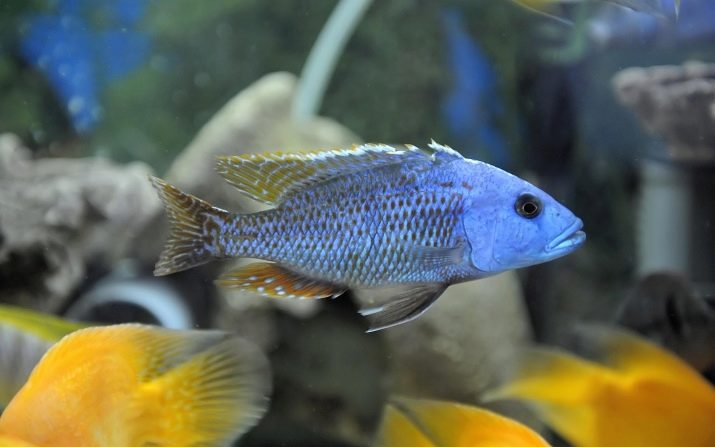
About the history of origin and features of this species of fish, see below.
